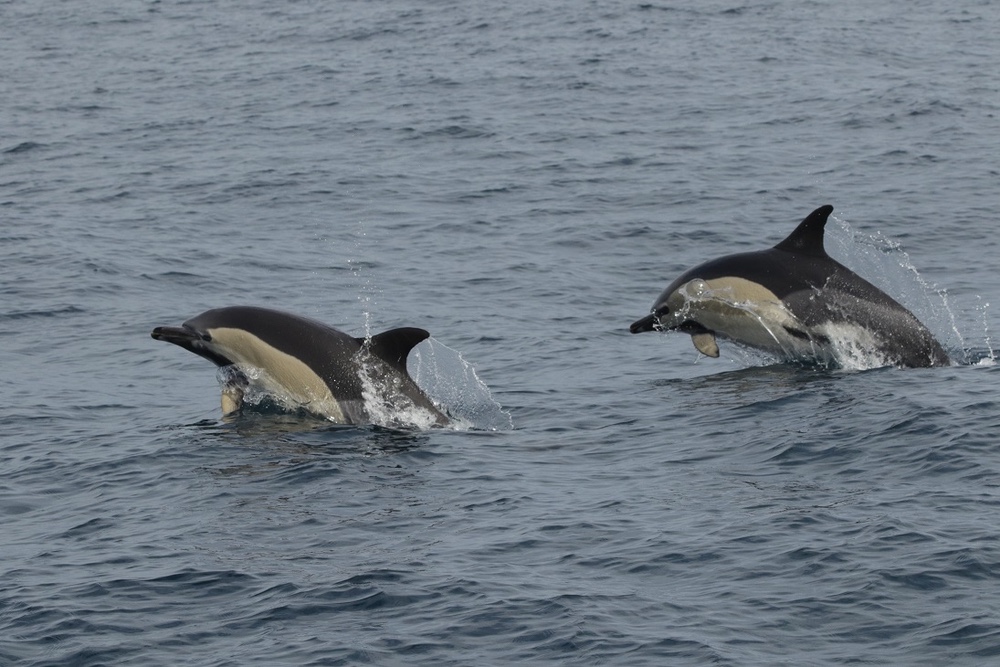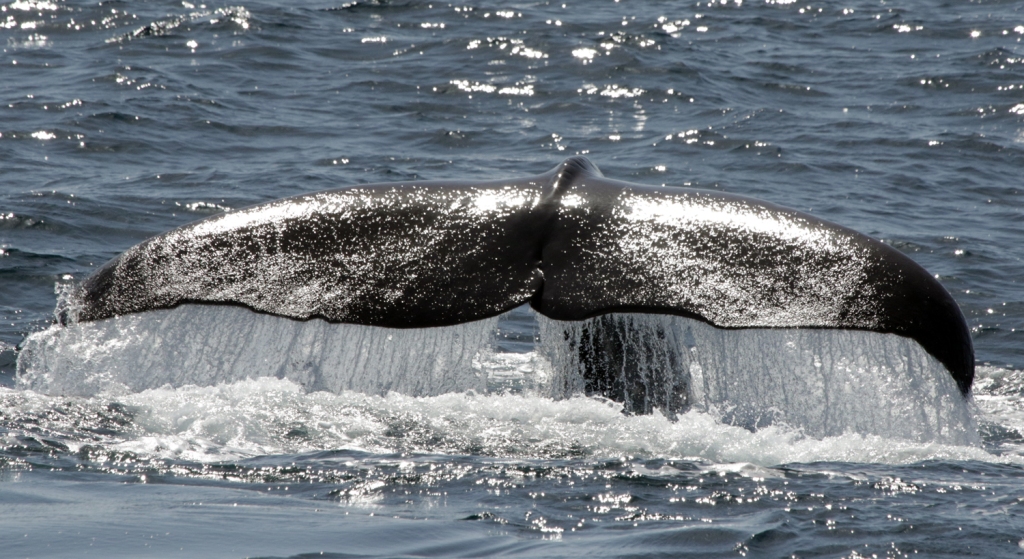Twenty-three expeditioners from ten countries across the world joined the Azores expeditions in March and April 2022, the first expedition to run since the start of the Covid pandemic. This was the 16th edition in the Azores monitoring the movements, migrations, numbers, group structures and ecology of cetaceans.
During this 16th expedition, citizen scientist participants spent 16 days out at sea, adding up to 100 sea-hours while covering 1674 km around the islands of Faial, Pico and Sao George in the central group of the Azores. The expedition’s search effort resulted in 127 sightings of 10 different cetacean species. In terms of abundance, the common dolphins come in first, while the iconic sperm whale was sighted on 59 occasions. Baleen whales are known to migrate through Azorean waters in spring, hence the timing of the expedition. The expedition recorded six humpback whales during three different encounters, one minke whale just outside Horta harbour and three majestic blue whales. As for dolphins, most of which are resident, the well-known bottlenose dolphins were spotted five times, Risso’s dolphins on four occasions and and striped dolphins twice. Of the larger toothed whales, the expedition witnessed a feasting bonanza of 75 false killer whales on tuna and even caught a glimpse of five elusive beaked whales.
Cetaceans are no easy species to study, given that they spend most of their time under the water surface. Yet photographs of dorsal fins of dolphins and tails (flukes) of whales allow scientists to distinguish individuals. These can then be matched when photographed elsewhere along their migration route or as part of their movements within the Azores archipelago. Photo-IDs may sit for many years in a database before being matched, hence cetacean research and spatio-temporal monitoring requires long-term data collection and processing to reveal meaningful patterns – a perfect task for a citizen science expedition. In the long run – and conservation science is a long game – this gives relevant information on priority areas to protect to safeguard the many whale and dolphin species present in the Azores. Indeed the archipelago is considered a hotspot for both resident and migrating cetacean species.
Out of the total of 59 sperm whale sightings, the expedition managed to identify 44 individuals of which 18 (40%) were known individuals and 26 (60%) were new individuals of which fluke shots were added to the catalogue. Actually, one sighting of one individual was repeated within the expedition, sighted both on 28 March as well as 19 April. Within the known individuals, there are three well-known groups: the one of a whale called “Nr 19”, the group of “1598” and the group of “2808”, with calves of last year. The expedition also spotted a few males, one of which known is known as “Tiktok”, a male that seem to be more resident around the Azores archipelago, often sighted close to Sāo Miguel. This is rather unusual, as most males migrate to the Northern Atlantic for food, while the females are known to stick around. These data are precious to Lisa Steiner, the expedition scientist, an expert on sperm whales, having studied them for over 35 years in the Azores. As Lisa says “cetacean research progresses one fluke at a time”. It is remarkable how she has come to know some of these individuals very well and we witnessed her jumping up and down on the lower deck in joy after taking a fluke shot, saying “this is number 19, I’ve know her since 1987!”
As for the humpback whales, one of the North Atlantic researchers for the species confirmed that one fluke photographed by the expedition matched to an individual seen in October 2014 and in January 2015 in the Tromso – Andenes region in the North of Norway. Our most unique sighting was the one of a white humpback whale, named “Willow”. It is the only known 95% leucistic individual in the Northern Atlantic humpback population. Based on this feature and together with its fluke ID, the expedition was able to confirm that Willow has been seen in the breeding grounds of Guadeloupe in 2015, 2019, 2020, as well as in the feeding grounds of Spitzbergen even earlier, in 2012. A tissue sample had been taken there, indicating Willow is a male. “This story and unique encounter demonstrates how every single fluke photo adds pieces of the puzzle that make up the life history of these long-lived migrating baleen whales” says An Bollen, the expedition leader.
Regarding the blue whales, the two individuals seen travelling together by the expedition were re-sightings from the Azores. One was seen there in 2010 and the other one in 2006, 2010, 2014 and 2018, as confirmed by the researcher Richard Sears, showing that at least some individuals use the same migration routes.
Dorsal fin photos were sorted by citizen scientists and have been sent off to Karen Hartmann, Risso’s dolphin researcher and to other colleagues working on bottlenose dolphins and false killer whales. These species are considered resident around the archipelago and indeed the expedition recognised some individuals with distinctive dorsal fins in groups of varying sizes, so as more feedback comes in form the colleagues, it will also add to an increased understanding of these dolphin species.
This year the expedition collaborated closely with the University of the Azores by testing the beta version of the Monicet app, which was released just before the start of the expedition. The expedition team provided several recommendations, which were included in an improved version, released by the end of April 2022. The idea is to roll out the use of the Monicet App to all whale watching vessels in the Azores to enable data collection and sharing. The expedition is proud to be asissting with this.
The expedition also worked with more advanced GPS units, which allow it to generate maps and other visualisations of results and effort.
This sums up the 16th Azores edition, which is only possible thanks to an international team of citizen scientists Lisa Steiner us and dedicating their free time, energy, resources and enthusiasm to collecting data and contributing to the conservation of these fascinating animals. Biosphere Expeditions will be back in March 2023 to continue its citizen science programme and keep contributing to long-term cetacean monitoring.
Some photo impressions of the expedition:


















































Some video impressions of the expedition:



































































































